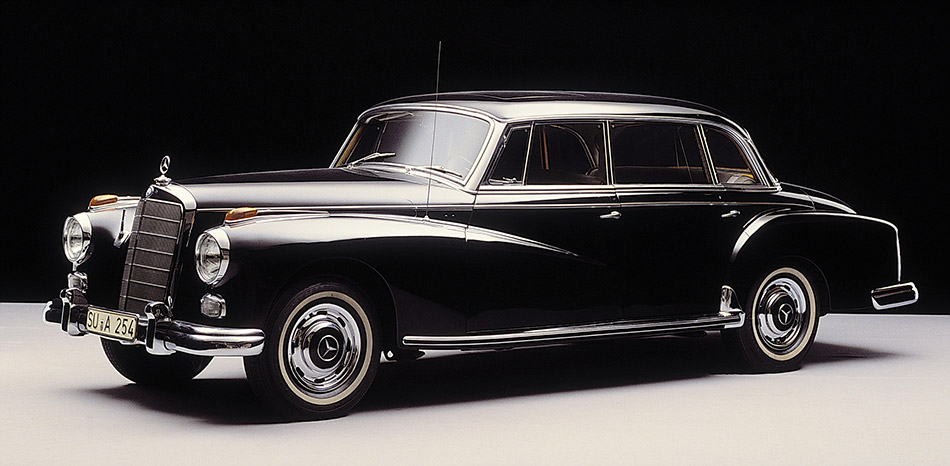The Model 300 received its most extensive revision in autumn 1957, resulting in a new model series designation, W 189. Not only did the longer wheelbase represent the standard dimensioning with immediate effect; the overall look of the vehicle had changed considerably: Hermann Ahrens turned his final passenger car design into reality. The tail end with the gently contoured side wings and the vertical tail light layout corresponded to those of the Model 220 coupé/cabriolet (W 180) and was given a larger boot. The front was also redesigned. The headlamps received trim rings projecting forwards in keeping with the style of the time. The rectangular fog lamps integrated into the wings formed a contrast to the round main headlamps.
Progress for the driver came in the form of the large rear window which extended over the entire width and was wrapped around the sides. In conjunction with the retractable side windows and thanks to a 30-per-cent increase in the overall window area this helped to create a totally new sense of light and space and a better all-round view. At the time this concept was referred to as the ‘pillarless full-vision body'.
With an eye to the American market the Model 300 d had very much been brought into line with the expectations regarding driving which existed there. Examples of this included the suspension tuning which differed considerably from that of the original Model 300 and was now designed for comfortable, relaxed cruising. This impression was underlined by the smoother but also more indirect manual steering and the power-assisted steering which was optionally available with the standard-specification automatic transmission. The three-gear automatic transmission enabled the car to stand still on a slope without rolling backwards. Plus, when gear ‘D' was engaged the first gear could now also be activated at speeds below 40 km/h by fully depressing the accelerator (‘kickdown'). In the predecessor it had only been possible to shift down from third to second gear in this way.
Passengers' wellbeing was enhanced by air conditioning from December 1958 onwards. Due to the additional charge that came with it, when the announcement about this new feature was made it was noted: ‘A cooling system has been developed for the 300. The gross price for this has been set at DM 3500. As this price hardly covers the material costs, a discount cannot be granted.'
The engine output was increased from 125 hp (92 kW) to 160 hp (118 kW) through the introduction of indirect manifold injection, so as to compensate at least partially for the higher vehicle weight. The tank capacity of 72 litres, which had been regarded as very mediocre, was now raised to 79 litres.
Within the exclusive series of the Model 300 d there was a special feature in the form of three vehicles specially built in 1960 which differed significantly from the usual saloons: a landaulet delivered to the Vatican for Pope John XIII., a second landaulet from the company's fleet which was loaned to the Federal government for state visits, and a saloon for the same purpose with a large sliding steel roof in the rear. These cars differed greatly from the normal vehicles of the model because of their wheelbase, which was extended from 3150 to 3600 millimetres. The overall length grew from 5190 to 5640 millimetres, the width from 1860 to 1995 millimetres and the height from 1620 to 1720 millimetres. The car's weight went up by 375 kilograms to 2365 kilograms.
|
Prices for the Mercedes-Benz 300 d (W 189) as per price list no. 6 dated 1 September 1957
|
|
|
Saloon with automatic transmission
|
28,500 DM
|
|
Saloon with manual transmission
|
27,000 DM
|
Leather upholstery (680 DM) and power steering (only with an automatic transmission, 750 DM) were not included in the price list. The prices were quoted in circulars no. 25/57 dated 12 September 1957 and no. 40/58 of 3 March 1958.
|
Price list no. 7 dated 1 September 1958
|
|
|
Sliding steel sunroof; not possible with partition
|
750 DM
|
|
Partition with rear compartment heater
|
950 DM
|
|
Continuous front bench seat
|
No extra charge
|
According to circular no. 67/58 dated 1 December 1958 the air conditioning cost 3500 DM. And the Cabriolet D was not included in the price list either – with an automatic transmission it cost 37,000 DM and with a manual transmission 35,500 DM, according to circular no. 69/58 dated 15 December 1958.
|
Mercedes-Benz 300 d (W 189) production figures
|
||||
|
Model
|
Design
|
Model variant
|
Production period
|
No. of units
|
|
300 d Saloon
|
W 189
|
189.010
|
08.57/11.57-03.62
|
3073
|
|
|
189.011 with sliding sunroof
|
Not separately recorded
|
||
|
|
Chassis
|
1
|
||
|
300 d Cabriolet D
|
W 189
|
189.033
|
07.58-02.62
|
136
|
In the mid-1950s, Daimler-Benz acknowledged that the Model 300's era was coming to an end, so head engineer Fritz Nallinger initiated work on a new ‘Super Mercedes' with the model series designation W 100. It was unveiled in 1963 as the Mercedes-Benz 600.
However, with the Model 300 the company had created a viable link between the Mercedes-Benz passenger cars, the Germany of the post-war period and young Federal Republic – both in terms of the vehicle's proportions and the stylistic reorientation that occurred in the years following the war. A Model 300 d as a vehicle for the Pope in the Vatican's fleet did not appear like an exotic foreign body – it looked as though it had always belonged there.
Source: Mercedes-Benz






















